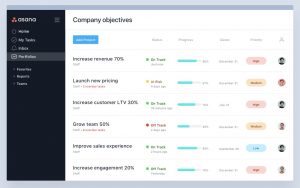
Asana already have a leading collaborative work management tool for enterprise organisations according to a recent Forrester Wave report. Enterprise Times spoke to Alex Hood, head of product at Asana about the new release and Asana’s recent growth.
Impressive growth trajectory
Asana last received funding in January, since then it has continued to grow and invest in the product. It now has 50,000 paying customers and more than 1 million organisations using the free version of the product, according to Hood. Asana has seen 6 continuous quarters of revenue growth, with an increase of around 90% ARR according to Hood.
Its international expansion started in Dublin, an office it is expanding. 50% of its customers are now outside the United States. Europe and Asia are the second and third most important markets respectively. Most of the international expansion has been organic. However, in the last year it has added language packs for French, Spanish, Portuguese and most recently Japanese.
Hood commented: “Since doing that we have seen even more gains. What that tells us is that it is a worldwide problem. It also tells us that companies that are working in a distributed manner, which is more and more common, are adopting Asana to create that clarity of purpose, plan and responsibility across their work.”
In terms of new product, it introduced Timeline earlier this year. Since then it has seen 40% of its customers adopt the solution. The latest update takes the task and project level focus of Asana to a higher level.
Portfolios
Historically Asana has offered company goals and milestones. However this was more a project that could be updated by a programme manager to reflect the status in company projects. Portfolios now enables programme managers and business leaders to create different hierarchies of projects that cascade up into a single dashboard. Hood commented: “Portfolios is the mission control for your companies most important initiatives.”
It goes a step beyond this and allows those programme managers to set priorities across a set of projects that they control. That programme manager might be an HR lead overseeing a set of HR projects or a technology leader looking across a range of projects. It allows organisations that have adopted matrix management to have an equivalent view across their projects.
Hood revealed that Tesco is already using portfolios. Hood explained: “Tescos uses Asana portfolios for their digital content delivery system. That is really planning their digital content and advertising across all seven of Tesco’s digital brand channels including web sites and apps. They use portfolios so that their teams have clarity on workload and workload availability. So that Tesco can then plan and manage ad hoc requests across the whole team.
“Because of this Tesco’s tells us they can better predict content delivery dates on projects. Teams are achieving their best work and then all of the timeframes that are promised internally get hit.”

Workload
Due to be generally available in 2019, Workload is an enhanced resource management tool. Hood explained what this does: ”Workload is where we are trying to optimally trying to distribute work across teammates. This calculation of knowing skills, interests, schedules current tasks on people plate. With that we bring in the information from profiles and look across all the things that are assigned to them in Asana and help load balance them across the team.”
While most vendors would call this resource management, Asana prefers to see this as a means of matching work with those “most passionate and talented about getting it done.”
It is targeted at programme managers who need to identify the best resources for the work requirements that they have. According to Hood it will also demonstrate where there is a shortfall of work and if they may need to bring in more resources. This does not, however, seem to be a resource forecasting tool that other PSA solutions often have as part of their functionality.
Both Portfolios and Workload will not be part of the standard offering. Instead Asana has created a new category of product Asana Business.
Asana Business
The new products form part of Asana business. This is targeted at larger organisations that need an oversight of projects. Asana Business includes both Portfolios and Workload. It is priced at $19.99 per user per month for an annual contract (€18.75, £16.25). It is also available on a rolling month contract at a slightly higher cost. This is a considerable uplift from Asana Premium at £7.99 per month for an annual contract. There is a further discount on the Premium product for teams of less than 15 people.
This may seem a large uplift but in comparison Wrike pricing for its business edition starts at $24.80 per month, though it does offer volume discounts. Trello Enterprise is $20.83 per user per month, again with volume discounts. It seems likely that Asana will also offer volume discounts on the new product, but this is not yet confirmed.
What does this mean
This is a logical development for Asana. It extends the functionality of the product and should also generate more revenues from its enhanced product. While some customers may feel that they would like the functionality as part of Asana Premium, that is probably unrealistic.
Nearly a year after its last funding round Asana will need to consider its revenue growth as well as the increasing market penetration. These features, though Workload is more of a mystery in terms of what it will actually provides, take the solution to a new level of sophistication. Can it stay in the collaborative work management space? Is it creeping towards a more sophisticated sector such as Professional Service Automation?
This announces shows that Asana is making a serious play for enterprise businesses who need this oversight. Dustin Moskovitz, co-founder and CEO, Asana commented: “In 2018 we introduced our multi-year vision for the future of work – emphasizing a world where people at all levels of an organization have clarity about their company’s objectives and how their work contributes to achieving them. Our vision is to help teams spend less time coordinating work and more time on the work that matters.
“With the introductions of Portfolios and Workload, we are delivering meaningful progress towards enabling organizations of all sizes and industries to move faster and spend more time on the work that makes an impact.”


























